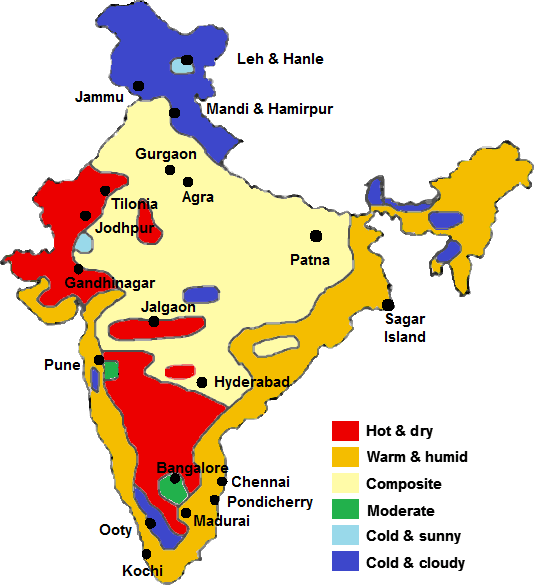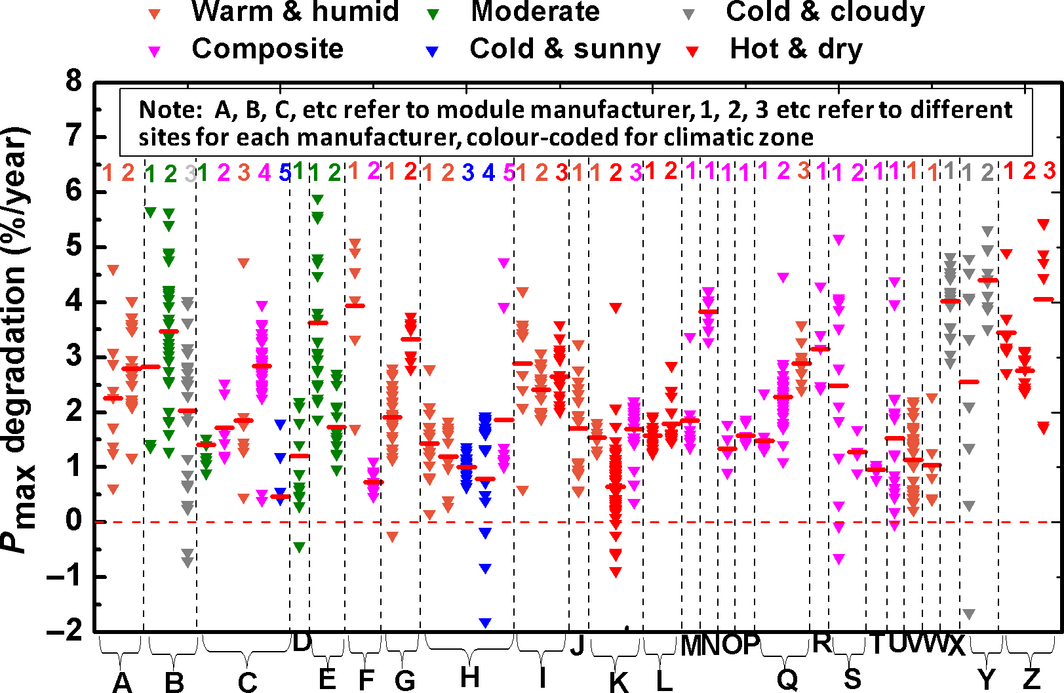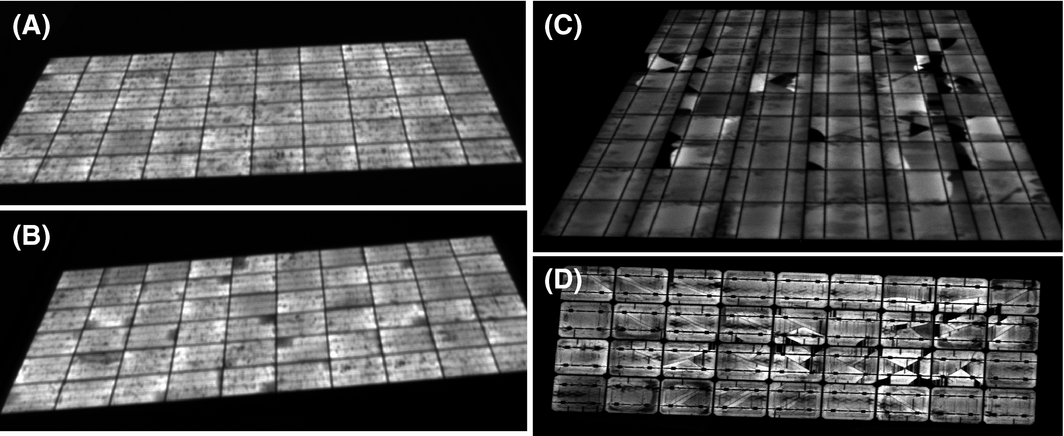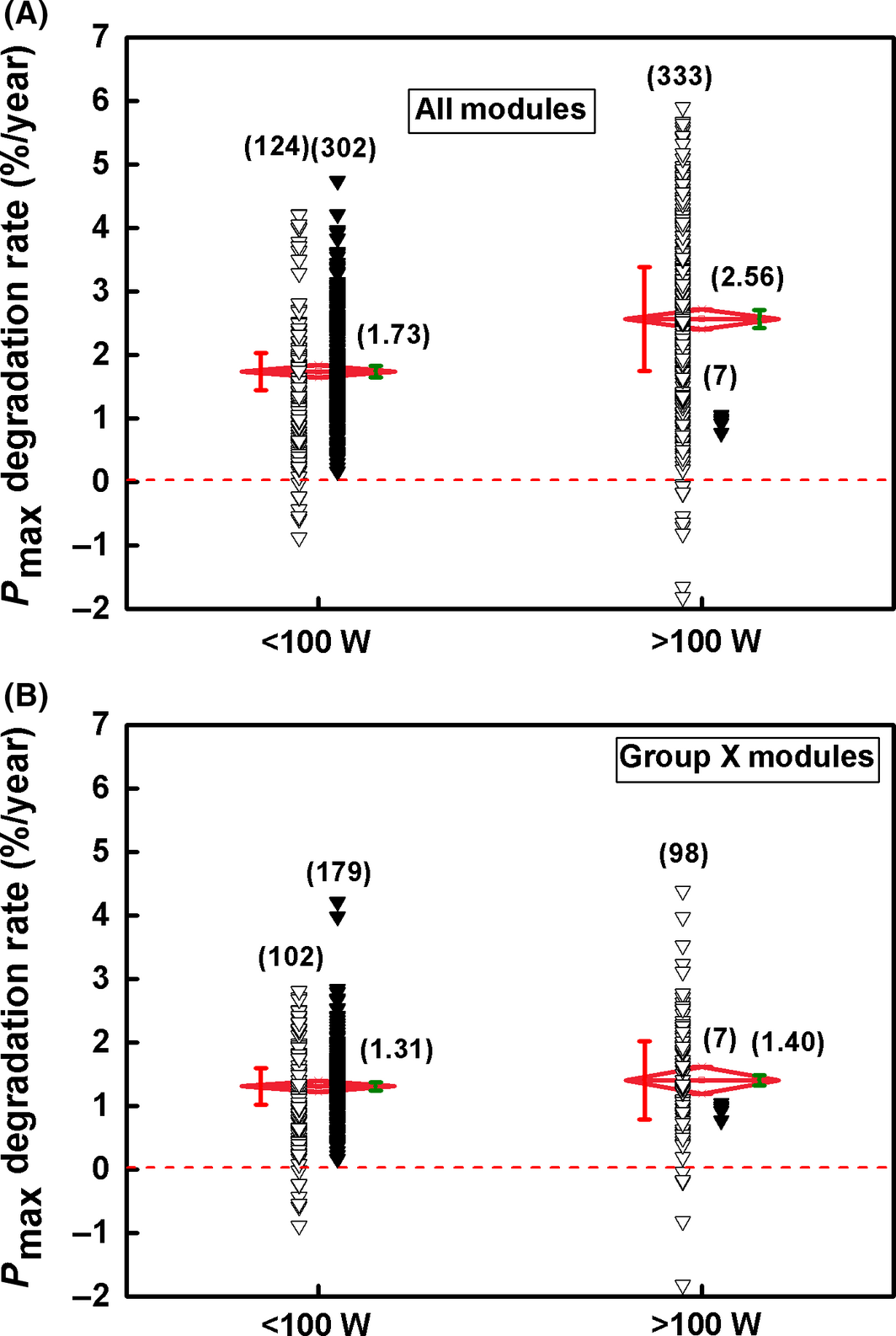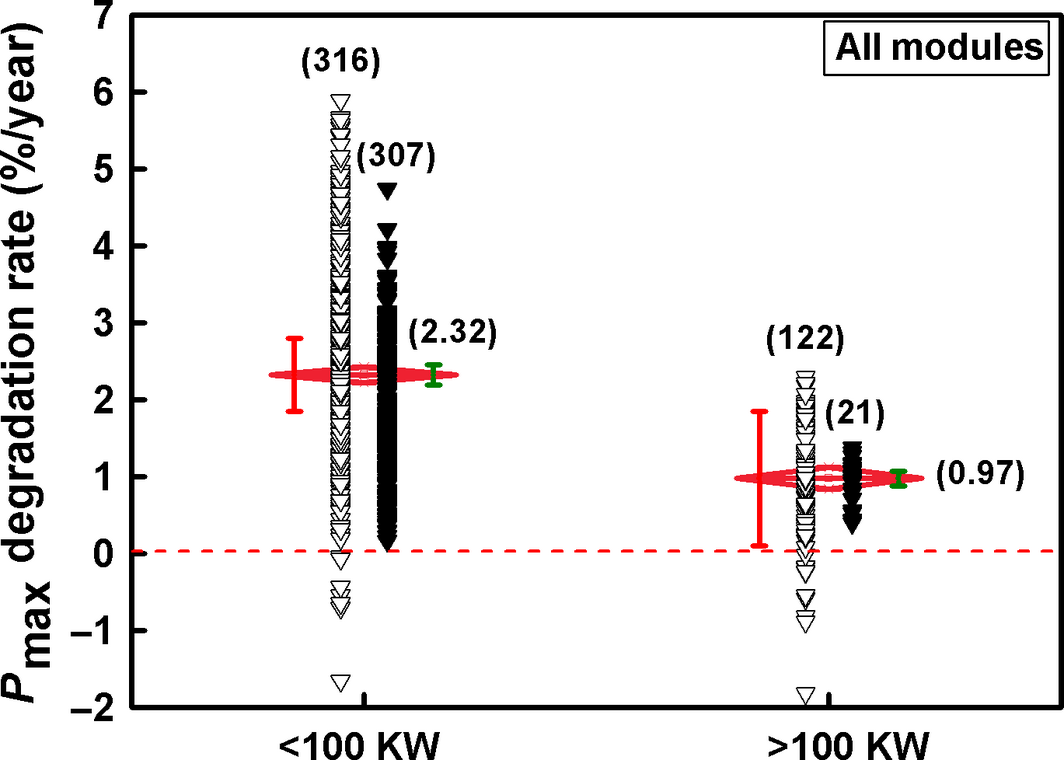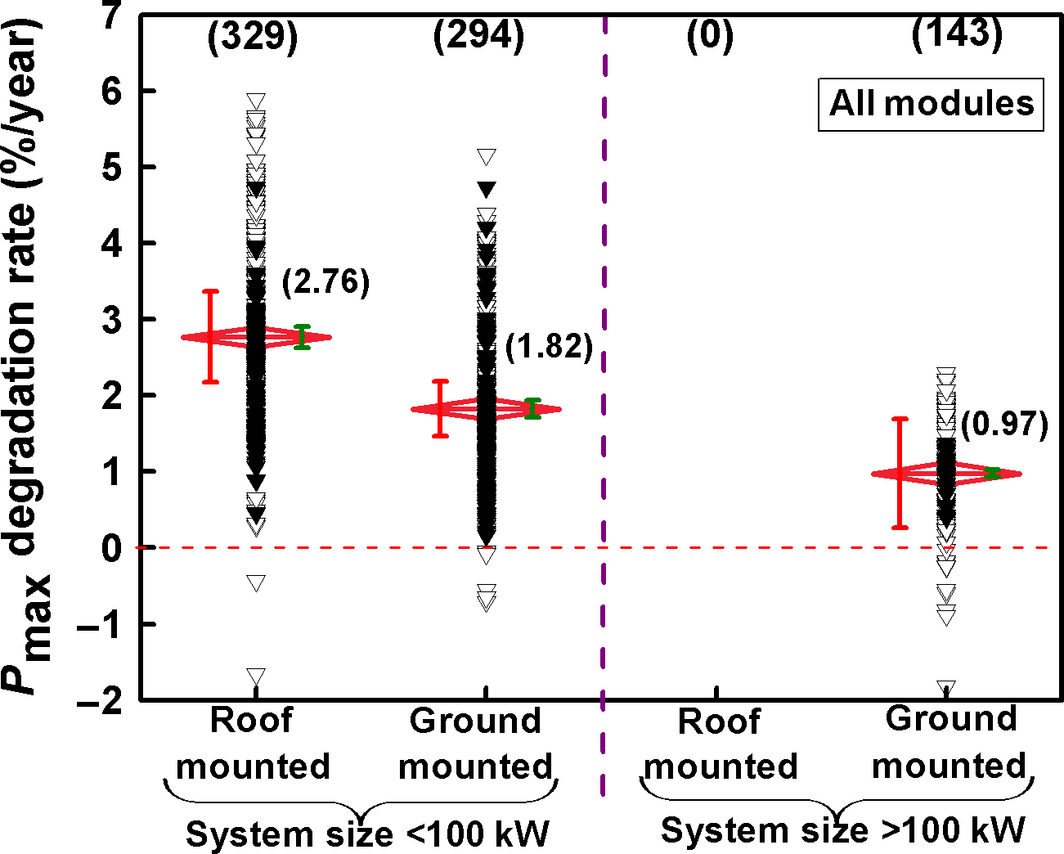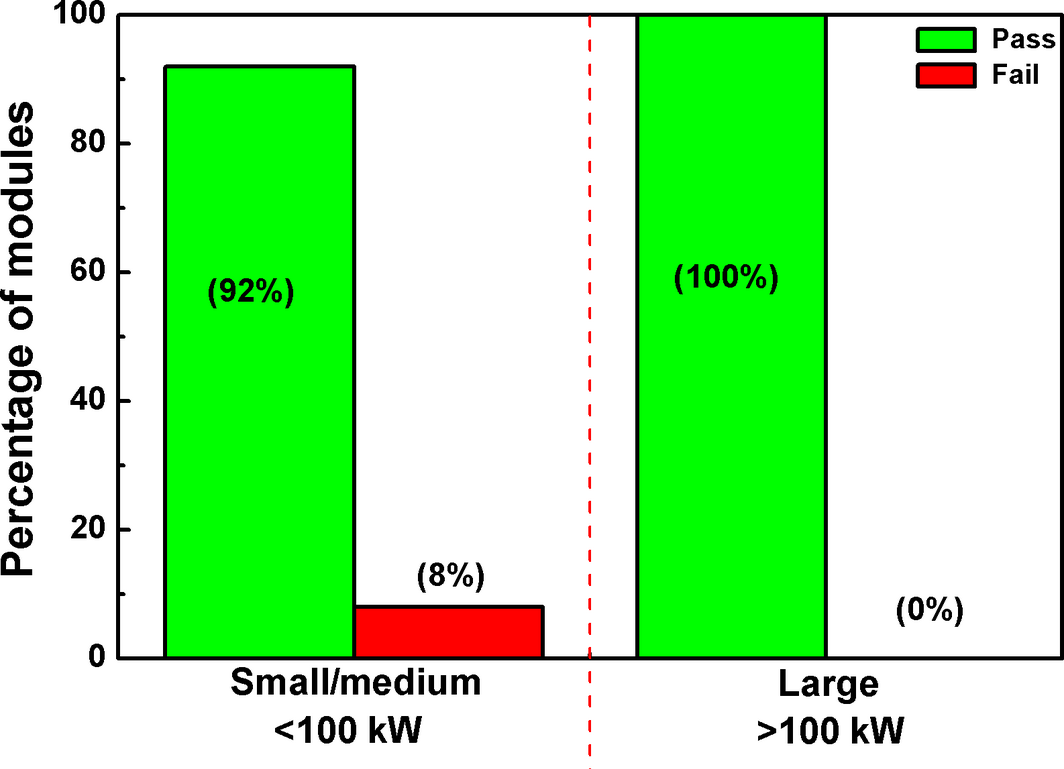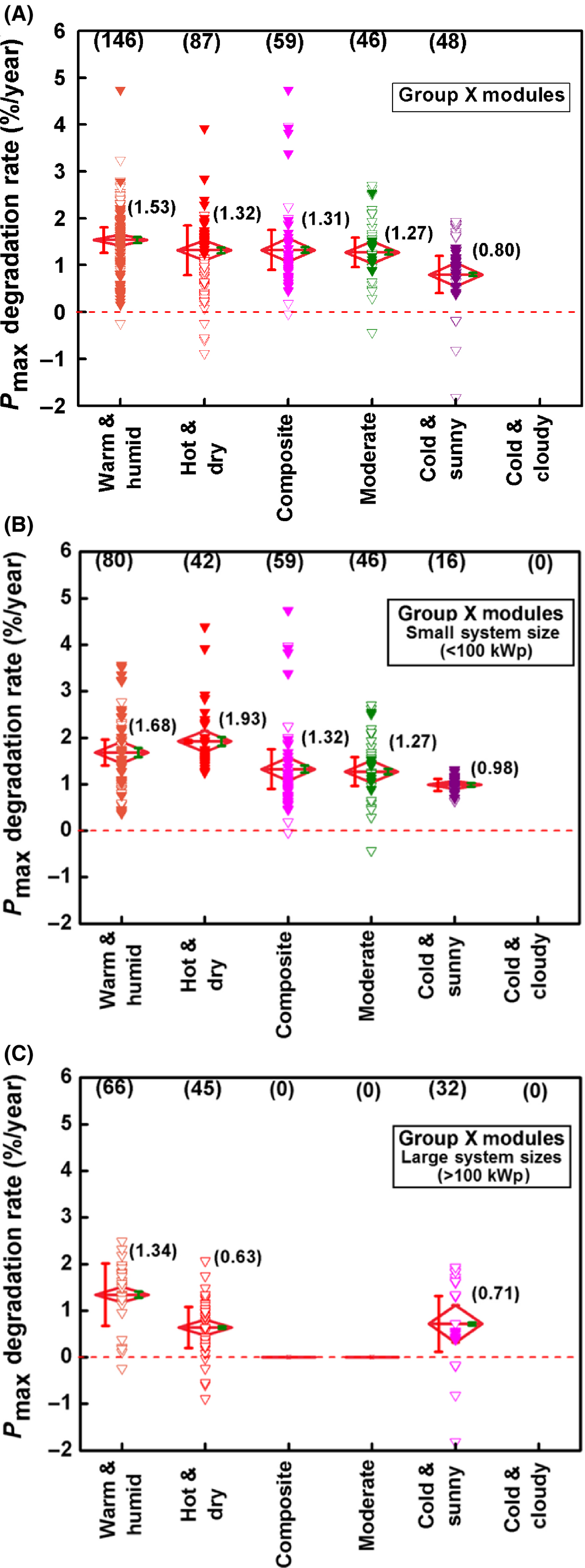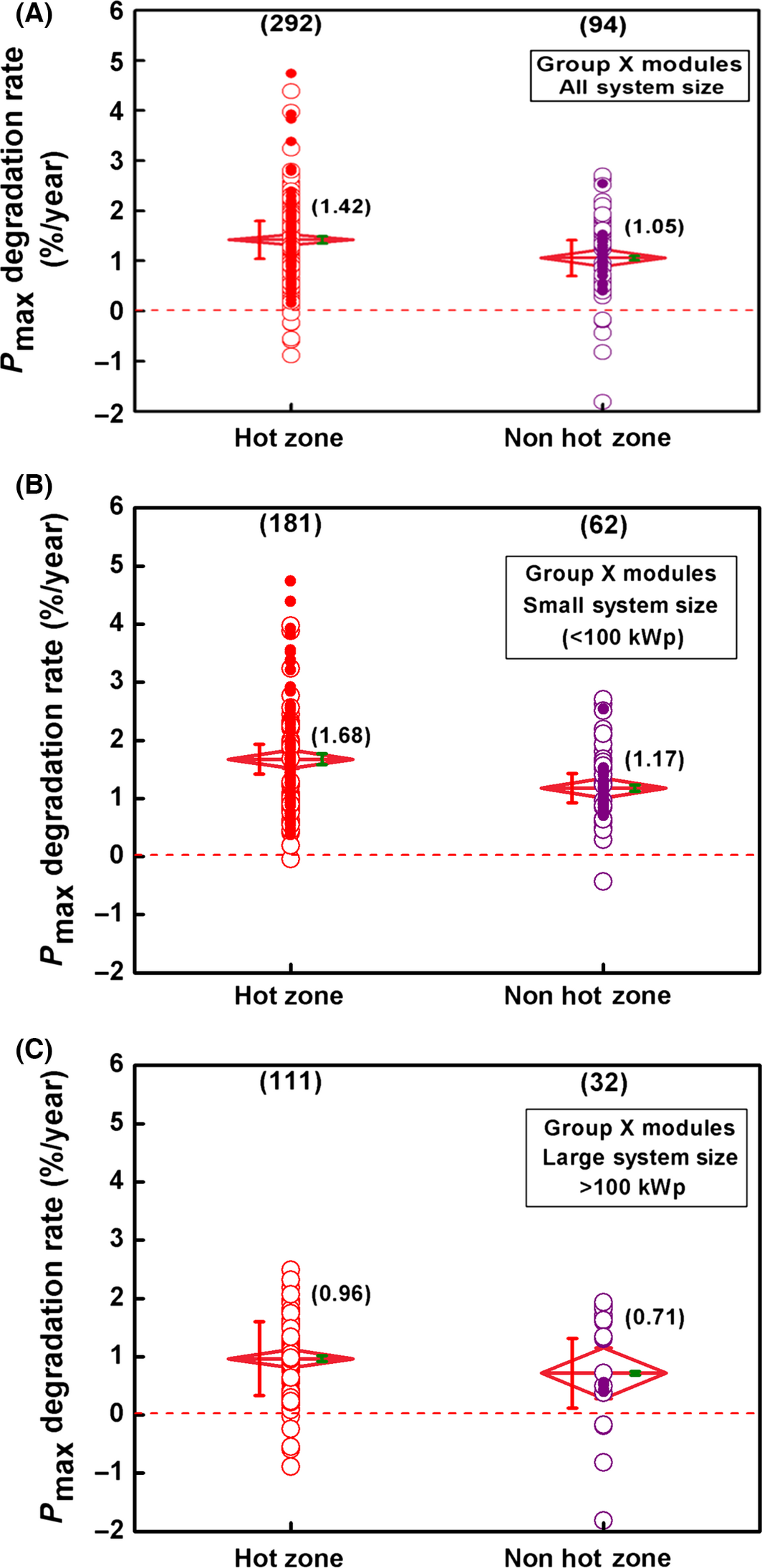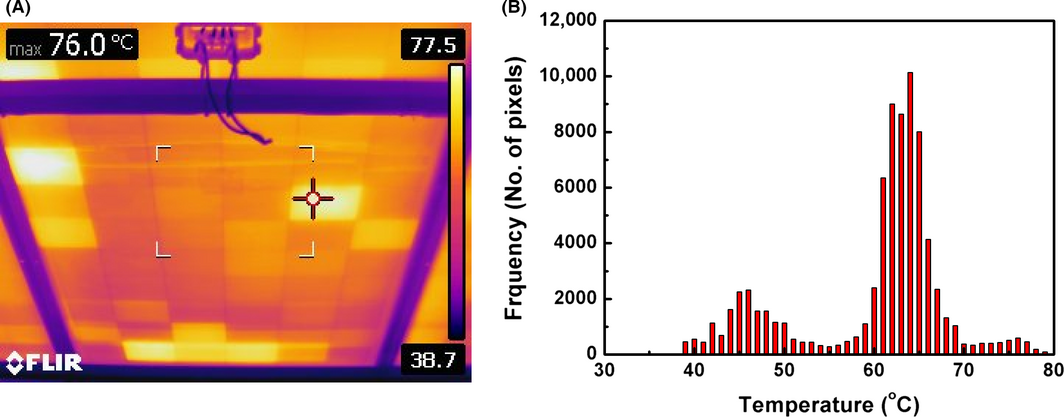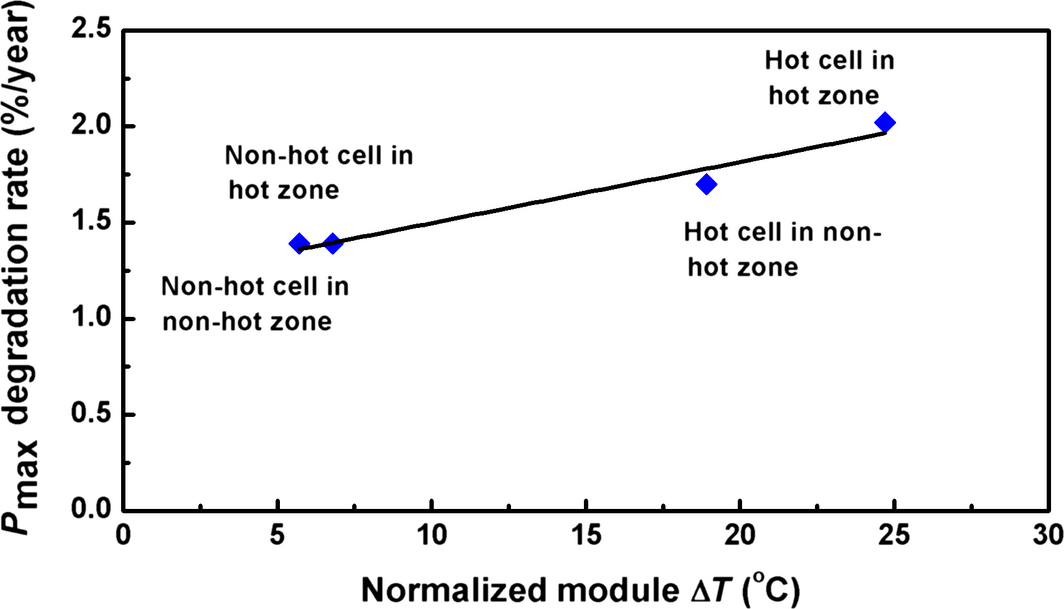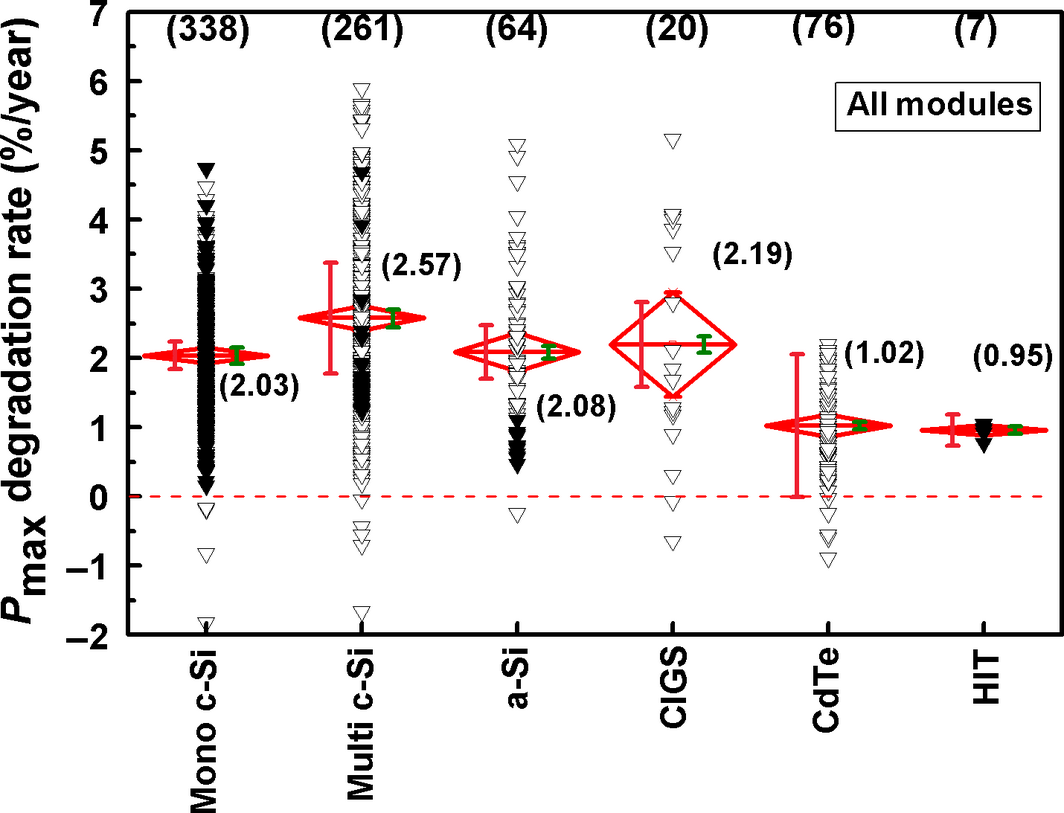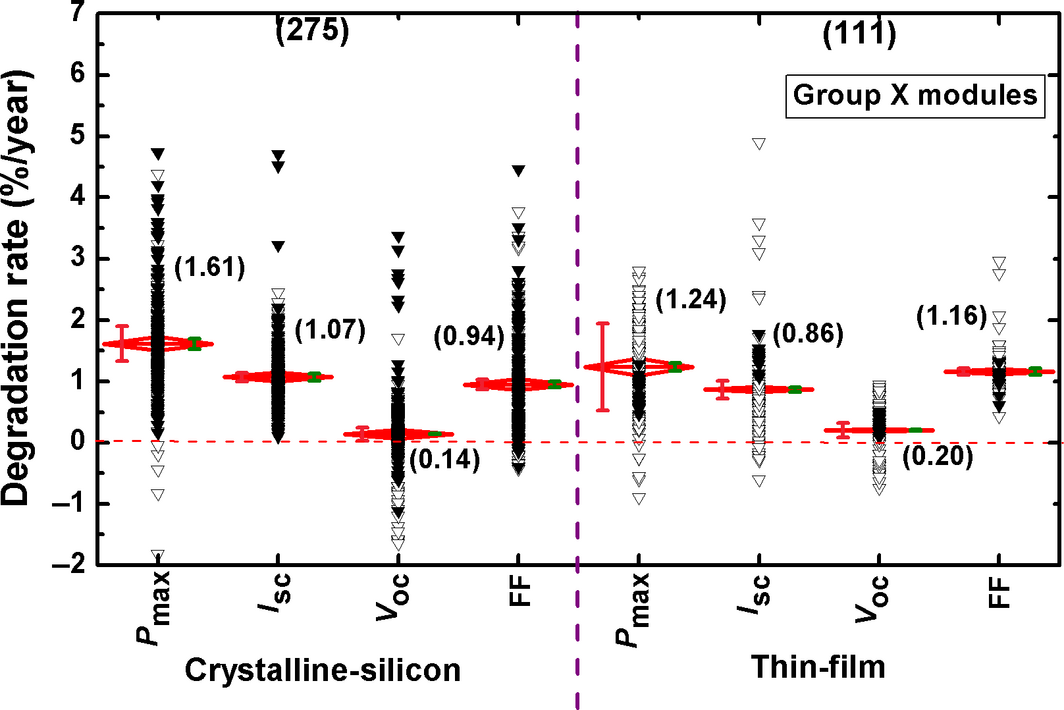Abstract
The All India Survey of Photovoltaic Module Reliability 2014 is an enhanced version of the survey conducted in the previous year, with detailed characterization of PV modules including current-voltage, infrared and electroluminescence imaging, visual inspection, insulation resistance test and interconnect breakage test. More than a thousand modules were inspected in the field and the main results of the survey are presented in this paper. The average Pmax degradation rate for the so-called ‘good’ modules (Group X) is 1.33%/year which is higher than that commonly projected by manufacturers, and widely employed in financial calculations. Modules falling in the ‘not-so-good’ category (Group Y) show even higher degradation rates, and it is at least partly due to higher number of micro-cracks in the modules, and increased degradation of the packaging materials like encapsulant, backsheet, etc. Modules in ‘Hot’ climates degrade faster than modules in the ‘Non-Hot’ climates. Degradation in fill factor is the primary cause for performance degradation in the young modules (ages <5 years), whereas short-circuit current degradation is the main contributor to power degradation in the older modules. Small installations (<100 kWp capacity) show higher degradation than large systems, which may be partly due to lack of proper due diligence by the owner at the time of procurement and installation.
Introduction
India has embarked on an ambitious plan to install 100 GW of solar power by 2022, under the Jawaharlal Nehru National Solar Mission (JNNSM), in order to reduce reliance on fossil fuels and help ameliorate global warming. Consequently, large solar power plants are being set up very rapidly, mostly in the western and southern states which are rich in solar resource. The present day installed solar power capacity in India stands at 8.1 GWp [1], out of which about 44% capacity has been added in the last 1 year. There is a disparity in the distribution of the solar power projects, with some of the largest power consuming states like Karnataka, Maharashtra, and Uttar Pradesh contributing <20% of the installed capacity [1]. Considering the enormous investments being made in solar photovoltaic (PV) power plants, it is important to understand the long-term performance of the PV modules in the Indian climatic conditions, since the energy yield would decide the ROI (return on investment) for the investors. The climatic conditions in India are very different from those of Europe, where solar panels have traditionally been installed in large capacities. In particular, the regions with high solar resource also tend to have hot climate, which may accelerate the degradation mechanisms due to the higher temperatures. It is necessary to evaluate the effects of the hotter Indian climate on the performance degradation of the solar panels, so as to enable installers and investors to take informed decisions on the investments they are making in this sector. Field surveys need to be conducted periodically to assess the actual on-the-ground realities of the solar PV technology. Some data are available from such surveys in other parts of the world. Jordan et al. [2, 3] reported that the average degradation rate for crystalline silicon modules is 0.8–0.9%/year whereas it is around 1%/year for thin film modules. They have indicated that hotter climates and mounting configurations may lead to higher degradation in some, but not all, products. Suleske et al. [4] have investigated the degradation of modules installed in a grid-tied power plant in Arizona, for 10–17 years, and has reported degradation rates ranging from 0.9%/year to 1.9%/year for nonhot spot modules, while for modules with hot spots, the degradation rate was found to be as high as 5%/year. Sastry et al. [5] have also reported that the degradation rates of crystalline silicon PV modules, monitored at their test bed at the National Institute of Solar Energy (NISE) in Gurgaon (near New Delhi) over a time of ten years, are more than the expected level [6]. Studies done by NISE on the performance analysis of different photovoltaic technologies (a-Si, multi c-Si and HIT) found that HIT and a-Si have performed better than multi c-Si [7, 8]. Furthermore, studies show that in the hot and dry type of climate, there is significant increases in the number of modules suffering from solder joint failure. Tamizhmani [9] have shown that modules in the hot climates of USA show a higher degradation rate than in other climatic zones. Kuitche et al. [10] have mentioned that for Hot and Dry type of climatic condition of Arizona, solder bond failure and discoloration are the two dominant failure modes. A comparative study of modules in different climatic zones in India and USA also indicates that modules degrade faster in hot climates [11]. It can be readily appreciated that comprehensive field surveys can yield a wealth of valuable information. The National Centre for Photovoltaic Research & Education (NCPRE) has been conducting ‘All-India Surveys of PV Module Reliability’ since 2013 in collaboration with the National Institute of Solar Energy (NISE) in order to evaluate the performance of PV modules in different parts of India. The 2014 edition of the survey has generated valuable data on the degradation of PV modules with respect to different climatic zones, technology, system size and age. In this survey, detailed characterization of the modules has been carried out in situ in the field, which is briefly explained in the next section, along with some of the important statistics which will allow us to understand the results.
Survey Statistics and Methodology
A total of 1148 modules were inspected in the six different climatic zones of India. India has a large geographic stretch, and different areas of the country experience very different climates –hot and dry, hot and humid, composite, moderate, cold and dry, and cold and cloudy [12]. This has been shown in Figure 1, along with the 19 locations marked in black dots, where 51 individual sites were surveyed by us during the 2014 All-India Survey. The details of sites and modules inspected in different climatic zones are given in Table 1. These comprised 983 c-Si modules and 165 thin film modules. Around 70% of the modules were young (0–5 years in age), around 20% were in the 10–20 years age group, and the remaining was older than 20 years. Almost 50% of the inspected modules had rated power >100 Wp, and 80% modules were connected to MPPT inverters.
|
|
|
Figure 1. Climatic zones of India as per Bansal and Minke [12]. The black dots indicate the locations surveyed. |
| Climatic zone | Number of sites surveyed | Number of modules surveyed |
|---|---|---|
| Hot and Dry (Hand D) | 15 | 194 |
| Warm and Humid (Wand H) | 10 | 333 |
| Composite (Comp) | 9 | 308 |
| Moderate (Mod) | 8 | 135 |
| Cold and Sunny (C and S) | 6 | 56 |
| Cold and Cloudy (Cand C) | 3 | 122 |
| Total | 51 | 1148 |
The methodology adopted for the survey has been explained in detail elsewhere [13, 14], but is being briefly mentioned here. At every site, the first activity was to clean the modules using water, followed by current-voltage (I-V) characterization of individual modules using PVPM and SolmetricI-V tracers. Infrared (IR) thermography was performed next using FLIR E-60 Infrared camera, with the module short-circuited for about 5 min. Interconnect breakage was tested, using Togami Cell Line Checker. Insulation resistance was measured both under dry and wet conditions, by applying a high voltage (1000 V DC) between the shorted module terminals and the module frame. Based on the above measurements, some of the modules were selected for further tests like dark I-V, dark IR, and electroluminescence (EL) measurement. EL was taken in the late afternoon or after sunset, in the presence of ambient light, using the “Image Difference Technique” which has been described elsewhere [15]. Dark I-V was performed with the module covered, using a programmable DC power supply. For dark IR, the module was forward biased at rated short circuit current, and IR images were taken from the back side.
Analysis of Survey Data
I-V data taken at irradiances below 500 Wm−2 were removed from the analysis, since translation of these I-V curves to standard test conditions (STC) will introduce very high error. For the rest of the data, taken above 500 Wm−2, the total error (which includes the instrument error and the translation error) is estimated to be <9%. Out of the 1148 modules inspected, the I-V data from 161 modules were discarded due to low irradiance measurement. Of the remaining 987 modules, 22% showed very high degradation rates (exceeding 6%/year), which were termed as “Outliers” and not considered for further analysis, as there appeared to be serious quality issues and other extraneous issues like over-rating. Figure 2(A) shows the histogram of the Pmax degradation rate of the remaining 766 modules, and it can be seen that there is a wide variation in the degradation rates, with the median and average of the histogram at 1.96%/year and 2.07%/year, respectively. These values are significantly higher than those reported by Jordan et al. [3], which raises concerns about the quality of the PV modules installed in India. The wide distribution in Figure 2(A) leads us to conclude that the quality of the modules and/or installation procedures vary significantly. There are ‘good’ sites, and there are ‘not-so-good’ ones. (Note that we cannot a priori distinguish between poor quality of modules used and poor transportation/installation procedures, both of which could lead to higher degradation rates). To understand this distribution better, we have plotted the degradation rate separately for each module manufacturer and site, as shown in Figure 3. In this figure, the x-axis represents the manufacturers (code named from A to Z to preserve anonymity) and the different sites for these manufacturers (1, 2, 3, etc.) are also mentioned at the top. For example, modules of manufacturer A were found in 2 sites, manufacturer B in 3 sites, C in 5 sites, and so on. Further, the data are color coded to represent the different climatic zones. It can be seen that some of the sites show tightly bound degradation rates, while others show a highly dispersed rate. Further the average degradation rate of modules at a particular site varies a lot from site to site. The red horizontal bar indicates the average Pmax degradation rate of each particular site. We therefore decided to divide the sites into two categories – Group X (sites where average degradation rate of the modules measured is <2%/year) and Group Y (sites where average degradation rate of the modules is more than 2%/year). The ‘2%/year’ criterion has been chosen somewhat arbitrarily, but was guided by the fact that the average degradation rate of all modules is 2%/year, as seen in Figure 2(A). The demarcation arising from the 2% criterion is purely empirical and therefore unbiased (we have not invoked tier ratings or reputation of the EPC), but, as will be seen later, leads to a good appreciation of the reasons for the wide variance, an understanding of the climatic variation, and receives support from other field observations such as visual, EL, IR, etc. Figure 2B and C show the histograms of the Pmax degradation rates of Group X and Group Y modules. The average degradation rate of Group X modules is 1.33%/year, which is almost half of the average degradation rate for Group Y modules, which shows that there is significant difference in the performance of these two groups.
|
|
|
Figure 2. Histogram of Pmax degradation rate of (A) ‘All’ modules, (B) Group X modules, and (C) Group Y modules. |
|
|
|
Figure 3. Manufacturer-wise and site-wise Pmax degradation rates. A through Z are the different manufacturers and 1, 2, etc. are the different sites for each manufacturer. Note that site 1 for manufacturer A is not the same as site 1 for other manufacturers, etc. |
Figure 4 shows EL images of some representative modules of Groups X and Y. Group X modules have lesser number of cracks as compared to group Y modules. According to Kontges et al., cracks can be classified into three categories [16]:
|
|
|
Figure 4. Electroluminescence images of some Group X modules (A), (B) and Group Y modules (C), (D) taken in the field. |
- Mode A cracks which are basically hair-line cracks, not associated with any dark area,
- Mode B cracks which are associated with a gray (not very dark) area in the cell,
- Mode C cracks which are associated with a dark area in the cell.
Table 2 shows the statistics for the 51 modules (consisting of a total of 1416 cells), for which we took the EL measurement. Many of these modules are older than 10 years, and have <60 cells per module. From Table 2, we can see that modules in Group Y have a larger number of cracks as compared to Group X modules. Hence, cracks in the cells are likely to be one of the reasons behind the higher degradation rate observed in group Y modules. Table 3 gives the statistics for modules affected (in percentage) by various types of visual defects, for Groups X and Y in different age groups. The values in brackets indicate the number of samples in the respective category. It can be seen that in most cases, a larger percentage of Group Y modules are affected as compared to Group X modules, which indicates that the material quality and/or manufacturing process is inferior in case of Group Y modules, which has led to higher Pmax degradation rates.
| Percentage of cells affected by different types of cracks | Total no. of cells | |||
|---|---|---|---|---|
| Mode A cracks | Mode B cracks | Mode C cracks | ||
| Group X | 2.4% | 14.1% | 3.2% | 972 |
| Group Y | 29.7% | 42.3% | 14.2% | 444 |
| Type of visual defect | Age groups | |
|---|---|---|
| Young (<5 years) | Old (>5 years) | |
| ||
| Discoloration | X: 9% (82) | X: 88% (148) |
| Y: 18% (219) | Y: 92% (135) | |
| Front-side delamination | X: 9% (82) | X: 31% (148) |
| Y: 16% (219) | Y: 43% (135) | |
| Snail trails | X: 35% (82) | X: 0% (148) |
| Y: 26% (219) | Y: 0% (135) | |
| Metallization discoloration | X: 38% (82) | X: 90% (148) |
| Y: 54% (214) | Y: 99% (135) | |
| Backsheet degradation | X: 26% (82) | X: 77% (148) |
| Y: 31% (219) | Y: 90% (135) | |
In the following sub-sections, the effect of system size, climate, technology, and age on the module performance will be discussed in detail.
Module size, system size and installation based variation
The inspected modules varied widely in their rated capacity, ranging from 10 Wp to 386 Wp. The smaller size modules (<100 Wp) are mostly old, while the larger wattages (>100 Wp) are seen only in recently installed systems. Figure 5 shows the variation in the power degradation rate for two categories of modules, with size <100 Wp and >100 Wp. In this and subsequent figures, each data point refers to an individual module, the number on top indicates the number of modules, the red horizontal bar shows the mean value, the diamond represents the 95% confidence interval, and the error bars refer to error due to name plate tolerance (left) and measurement and translation (right). If relevant, the symbols are color coded to represent climatic zone, and open or filled representing young (<5 years) or old (>5 years) modules. We can see that when considering modules from ‘All’ sites (refer Fig. 5A), the smaller capacity modules show less degradation on the average as compared to the larger size modules. However, the same comparison done only considering Group X modules does not show such a wide difference, as seen in Figure 5(B), which indicates that for the good sites, the degradation rate does not depend on module size. On the other hand, for the ‘not so good’ sites (Group Y), there is a very strong dependence, with the larger size modules (which are Young in age) showing much higher degradation rates.
|
|
|
Figure 5. Effect of module size on Pmax degradation rate for (A) ‘All’ modules (B) Group X modules. |
To understand the effect of the system size (as distinct from module size) on the degradation rate, the surveyed sites have been segregated into two groups– small/medium systems (size ≤100 kWp), and large systems (size more than 100 kWp). Figure 6 shows the effect of system size on the performance degradation rate of surveyed modules. It is evident that large systems show lower degradation in performance as compared to smaller systems, the reason for which may be attributed to the greater due diligence and better installation practices adopted for the large systems, which may be lacking in the case of smaller systems. If we compare the mounting location – roof-mounted versus ground-mounted (Figure 7) – we come to the conclusion that roof-mounted systems show higher degradation rates than ground-mounted systems. This may be due to lack of proper due diligence on part of small PV system installers and owners which might result in use of lower grade materials, and also since roof-mounted modules tend to run hotter.
|
|
|
Figure 6. Effect of system size on Pmax degradation rate for ‘All’ modules. |
|
|
|
Figure 7. Effect of installation type on Pmax degradation rate for ‘All’ modules. |
Figure 8 shows the percentage of modules which passed or failed the dry insulation resistance test for small/medium systems and large systems. It is evident that the modules in large installations perform slightly better than small/medium installations, and 100% of the modules in the large installations have passed the dry insulation test.
|
|
|
Figure 8. Percentage of modules passed or failed dry insulation resistance test for small/medium and large installations. |
The severity level of material degradation has been quantified based on the degree (intensity) of the defect and the affected fractional area, estimated by visual inspection. The degree of the discoloration can be light (yellow) or dark (brown), and the fractional cell area can range between 0 and 1. The discoloration index for the module is calculated as given below:
|
|
(1) |
where degree of discoloration = 1 for light/yellow discoloration, = 2 for dark/brown discoloration; normalizing factor = 2 (based on maximum possible value of numerator).
Based on the discoloration index, the modules can be grouped into 5 categories as follows, with the severity of discoloration ranging from ‘Nil’ to ‘Very High’ as given in Table 4.
| Discoloration index | 0 | 0–0.25 | 0.25–0.5 | 0.5–0.75 | 0.75–1 |
| Discoloration category | Nil | Low | Medium | High | Very high |
Similarly, modules have also been classified into five severity categories for the other defects like delamination, snail trails, etc. The severity levels in increasing order of magnitude are ‘Nil’, ‘Low’, ‘Medium’, ‘High’ and ‘Very High’. Detailed explanation of the methodology for arriving at the severity levels is given in a separate publication [17]. Table 5 shows the average severity level of the major visual defects found in the surveyed modules for small and large installations. Severity of front-side delamination and backsheet degradation is higher in the Young modules from small installations as compared to large installations. Among the Old modules, the severity of discoloration, delamination, metallization discoloration, and backsheet degradation are all higher for the modules in small installations, but the number of samples is very small for large installations to give a definitive picture. Overall, it may be said that severity of these defects points toward manufacturing and/or installation related issues with the modules in small installations.
| Type of visual defect | Size of installation | Age groups | |
|---|---|---|---|
| Young | Old | ||
| |||
| Discoloration | Small | Low (519) | Medium (361)a |
| Large | Low (50) | Nil (5) | |
| Front-side delamination | Small | Low (519) | Low (399) |
| Large | Nil (50) | Nil (5) | |
| Snail tracks | Small | Medium (519) | Nil (399) |
| Large | Medium (50) | Nil (5) | |
| Metallization discoloration | Small | Low (514)b | Medium (399) |
| Large | Low (50) | Low (5) | |
| Backsheet degradation | Small | Low (519) | Medium (399) |
| Large | Nil (50) | Low (5) | |
Table 6 shows the result of analysis of infra-red images for 136 modules belonging to Group X, which have been segregated based on the type of mounting and the climatic zone. In the hot zone, modules mounted on the roof have on an average 5°C higher temperature as compared to modules on the ground. It should be noted that the modules on the rooftop were placed on open racks, and not directly on roof. Based on the above discussion, it is evident that the modules on rooftops, usually in small installations, run hotter, besides having material quality and installation related issues, which results in a higher degradation rate.
| Translated module temperature (°C) | Hot zones | Nonhot zones | ||
|---|---|---|---|---|
| Roof | Ground | Roof | Ground | |
| Median | 67.63 | 60.85 | 49.20 | 46.35 |
| Average | 65.52 | 59.75 | 46.14 | 45.76 |
| No. of samples | 37 | 37 | 40 | 18 |
Climatic zone variation
The effect of climatic zone on the Pmax degradation rate is shown in Figure 9. Figure 9(A) shows the plot for all system sizes; Figure 9B and C show the plots for small and large systems, respectively. We focus on the climatic variation of the ‘good’ Group X modules, since the degradation of Group Y modules is likely to be dominated by other factors like quality, installation, etc. When considering all system sizes (Fig. 9A), the average degradation rate for Group X modules is highest in warm and humid zone, closely followed by the hot and dry zone and the composite zone, and is lowest in the cold and sunny zone. This trend is more clearly visible when looking at the degradation rates of only small-sized systems (Fig. 9B) with a minor difference being that the small systems in the hot and dry climate are degrading faster than those in the warm and humid climate. For modules in large systems (Fig. 9C), the trend is almost similar, except for the very low average degradation rate in hot and dry due to the presence of CdTe modules in this category (which are degrading at a much lower rate as compared to all other technologies). Since the average temperatures seen in the first there zones (warm and humid, hot and dry, and composite) are all quite high, these may be clubbed together into the so-called ‘Hot’ zone, while the moderate, cold and sunny, and cold and cloudy zones may be clubbed together into the ‘Non-Hot’ zone. Figure 10(A) shows that the Pmax degradation rate is about 35% higher in the Hot zone (1.42%/year) as compared to the nonhot zone (1.05%/year), when considering all system sizes. This is understandable since the degradation processes for the various constituent materials of PV modules are accelerated by higher temperatures. Figure 10B and C show the degradation rates of power for small and large systems, respectively. The large systems have almost similar degradation rates in hot and nonhot climates, but this is not the case for the small systems. Thus, small systems are more affected by the climate (hot or nonhot) while the large systems tend to be less affected (which may be because the material quality, installation practices, and maintenance may be better in the large systems).
|
|
|
Figure 9. Comparison of Pmax degradation rate with respect to six-zone classification system for Group X modules, for (A) all system sizes (B) Small system sizes (<100 kWp) (C) Large system sizes (>100 kWp). |
|
|
|
Figure 10. Comparison of Pmax degradation rate with respect to hot and nonhot zone for Group X modules, for (A) all system sizes (B) Small system sizes (<100 kWp) (C) Large system sizes (>100 kWp). |
Table 7 shows the effect of hot cells and module temperature on the modules power degradation rate in the hot and nonhot climatic zones. The mode of the temperature histogram (Tmode, as shown in Fig. 11B) of a module has been considered as the modules representative temperature. The difference in the maximum cell temperature of the module (Tmax in Fig. 11B) from the modal temperature (Tmode in Fig. 11B) is referred to as module ∆T. For a meaningful comparison, the module temperatures measured in the field need to be translated to reference conditions of 1000 Wm−2 irradiance and 40°C ambient temperature [18, 19]. The following relation is used to translate the module ∆T to the reference conditions:
|
|
(2) |
| Parameter (average of many samples) | Hot zone | Nonhot zone | ||
|---|---|---|---|---|
| Without hot cells | With hot cells | Without hot cells | With hot cells | |
| Power degradation rate (%/year) | 1.39 | 2.02 | 1.39 | 1.70 |
| Normalized module ∆T (°C) | 6.8 | 24.7 | 5.7 | 18.9 |
| Normalized maximum cell temperature (°C) | 68.8 | 86.1 | 50.3 | 58.6 |
| No. of samples | 10 | 18 | 14 | 17 |
|
|
|
Figure 11. Infrared (IR) image of a PV module, (A), and its temperature histogram extracted from the IR image, (B), showing mode of 63°C and maximum temperature of 79°C, so the module ΔT is 16°C [20]. |
If the translated module ∆T is >10°C, we have considered the module to be having Hot Cells [21]. We can see from Table 7 that modules with Hot cells are degrading faster than modules without Hot cells, and this degradation rate is higher in the hot zone as compared to the nonhot zone. This trend agrees well with the normalized (translated) module ∆T, which is found to be highest for modules with hot cells in hot zones. The maximum cell temperature is also highest for this category. Modeling and simulation [22] results show that there is very little heat transfer from the Hot cells to the surrounding connected cells. These Hot cells are created under short-circuited condition usually due to mismatch in photo-currents. Figure 12 plots the power degradation rate versus the normalized module ∆T, which shows a positive correlation between the two.
|
|
|
Figure 12. Correlation of power degradation rate with normalized module ΔT. |
Table 8 shows the average severity of visible defects for Group X modules. The severity levels in increasing order of magnitude are ‘Nil’, ‘Low’, ‘Medium’, ‘High’ and ‘Very High’. Detailed explanation of the methodology for arriving at the severity levels is given in a separate publication [17]. Among the Old modules, the average severity of discoloration, delamination, metallization discoloration, and backsheet degradation are all higher for modules in Hot zones as compared to nonhot zones. Among the Young modules, snail tracks are more severe in hot zones than the nonhot zones. Hence, it can be said that, in general, modules in hot zones show more severe material degradation than modules in the nonhot zones.
| Type of visual defect | Climatic zone | Age groups | |
|---|---|---|---|
| Young | Old | ||
| Discoloration | Hot | Low (51) | High (155) |
| Nonhot | Low (64) | Medium (34) | |
| Front-side delamination | Hot | Nil (51) | Low (193) |
| Nonhot | Low (64) | Nil (34) | |
| Snail tracks | Hot | Medium (51) | Nil (193) |
| Nonhot | Low (64) | Nil (34) | |
| Metallization discoloration | Hot | Low (46)** | Medium (193) |
| Nonhot | Low (64) | Low (43) | |
| Backsheet degradation | Hot | Low (51) | Medium (155) |
| Nonhot | Low (64) | Low (34) | |
The percentage of Group X modules affected by interconnects breakage in different climatic zones and age groups are presented in Table 9. Interconnect breakage test has been performed on crystalline silicon modules, using Togami Cell Line Checker. It has not been found in the young modules, and among the old modules, those in the hot and dry climate seems to be affected the most, followed by the warm and humid climate. This is due to stress caused by thermal expansion and contraction as a result of daily thermal cycling. Also moisture induced corrosion causes loss of adhesion strength. Such a trend is also reported in literature for modules installed in the USA [10, 23].
| Climatic zone | 0–5 years | 5–10 years | 10–20 years | 20+ years |
|---|---|---|---|---|
| Hot and Dry | NA | NA | 100% (20) | 2.6% (38) |
| Warm and Humid | 0% (24) | 28% (39) | 54% (26) | NA |
| Composite | NA | NA | 34% (30) | NA |
| Moderate | 0% (31) | NA | 16% (12) | NA |
| Cold and Sunny | 0% (33) | NA | 35% (17) | NA |
| Cold and Cloudy | NA | NA | NA | NA |
Based on the above discussion, it can be concluded that climate has a significant influence on the performance degradation rates, with modules degrading faster in hot zones as compared to the nonhot zones. Modules in the hot zones suffer from faster packaging material degradation and higher incidence of interconnect breakages as compared to modules in nonhot zones.
Technology based variation
Different technologies of PV modules show different degradation rates as shown in Figure 13. Multicrystalline silicon modules are found to degrade slightly faster than mono c-Si modules. The average degradation rate for some of the thin film technologies like CIGS, CdTe and HIT is found to be lower than the c-Si modules. This may be due to the fact that we encountered modules from only one manufacturer for these thin film technologies, whereas for the c-Si modules there were multiple manufacturers, including reputed experienced manufacturers and also relatively unknown manufacturers. Also, since the number of samples for some of the technologies like HIT and CIGS is very less, no definitive conclusion can be arrived at for these technologies. Jordan et al.[3] have indicated that the average degradation rate for CdTe modules has been observed to be around 0.6%/year (based on multiple reports) while the degradation rates for amorphous silicon power plants from various parts of the world has been reported to be within 1%/year in general. Also, the degradation rate for c-Si is commonly reported to be within 1%/year [3]. These values are lower than those seen in our survey, and raises concern about the long term performance of these modules in India. Figure 14 shows the degradation rates for all the I-V parameters like short circuit current, open circuit voltage and FF, for Group X crystalline silicon and thin film modules. It can be seen that in case of c-Si modules, the degradation in Pmax is mainly caused due to degradation in Isc, followed by FF, and lastly by Voc, whereas for thin film modules, it is mainly the degradation in FF which causes this loss of performance, followed by Isc degradation. The degradation in Isc in c-Si is mainly due to discoloration, delamination and cracks in the cell. A small extent of degradation of Isc is due to light-induced degradation and soiling [24, 25]. Corrosion and solder-bond breakage causes the degradation in the FF for the c-Si module. In the case of thin films technologies higher value in FF degradation is seen as compared to c-Si which is due light-induced degradation of a-Si and an increase in series resistance in CIGS [26].
|
|
|
Figure 13. Pmax degradation rate for different technologies for Group X modules. |
|
|
|
Figure 14. Pmax, Isc, Voc, and FF degradation of different technologies for Group X modules. |
The predominant defect observed in young crystalline silicon modules is snail trails, which is mostly due to cracks in the solar cells. The cracks tend to increase the series resistance of the modules, and may also cause power loss (depending on the type of crack) [16]. In case of thin film modules, the predominant defect is white spots, which form due to embedded impurities during the manufacturing process owing to improper cleaning of the substrate glass [26]. For the old crystalline silicon modules, the predominant visual defect is encapsulant discoloration, which reduces the short circuit current, and corrosion of metallization, which reduces the fill factor.
Age based variation
The influence of module age on the degradation rate of c-Si modules is shown in Figure 15. In the young modules, FF degradation is the primary cause of degradation in Pmax, whereas in the old modules, Isc degradation is the main reason. Pmax degradation rate is higher for old modules as compared to young modules in case of Group X but this trend reverses for ‘All’ c-Si modules. Another interesting fact which emerges is that whereas in old modules Pmax degradation is dominated by Isc degradation due to encapsulant browning, in young modules it is dominated by FF degradation probably due to series resistance caused by more cracks as shown below in Table 11. This indicates that the young modules in Group Y have higher degradation rates than the old modules, which suggests that the raw materials and/or manufacturing process and/or installation practices are not optimized or well-controlled.
|
|
|
Figure 15. Effect of age on Pmax, Isc, Voc and FF degradation of crystalline silicon modules for (A) Group X, and (B) ‘All’. |
With aging, the materials in the module degrade due to one or more of the various environmental factors like UV radiation (from sunlight), daily temperature cycling, humidity, etc. The percentage of modules affected by interconnects failure in hot and nonhot zones have been shown in Table 10. The young modules do not have any interconnect breakage, whereas a high percentage of old modules show breakage, particularly in the Hot zones. Temperature cycling (hot in daytime and cooler at night) has been identified as one of the major causes of interconnect failure in the field [10]. Also, with aging, there is increase in encapsulant discoloration, delamination, corrosion and backsheet degradation, as evident from Tables 3, 5 and 8.
| Climatic zone | Young modules | Old modules |
|---|---|---|
| Hot zones | 0% (24) | 43% (153) |
| Nonhot zones | 0% (64) | 28% (29) |
From Table 11, it is evident that percentage of cracked cells in young modules is more than that in old modules, which hints that the transportation and/or installation practices for young modules has not been carefully undertaken. Also, the present day modules have thinner cells, which make them more susceptible to cracks as compared to the cells in the older modules.
| Percentage of cells affected by different types of cracks | Total no. of cells | |||
|---|---|---|---|---|
| Mode A cracks | Mode B cracks | Mode C cracks | ||
| Young modules | 37.9% | 14.9% | 12.2% | 408 |
| Old modules | 0% | 26.2% | 4.4% | 1008 |
Conclusions
It is important to understand the performance of the PV modules in actual operating conditions in the field, considering the large investments which are being made for setting up utility scale PV power plants in the near future. The degradation rates have serious implications on the return-on-investment calculations of investors, and can make the difference between a financially successful and unsuccessful project. Field data obtained during the 2014 All-India Survey of Photovoltaic Module Reliability have been analyzed in detail. This shows that there is a wide variation in the annual module degradation rate, and the average degradation rate for the so-called ‘good’ (Group X) sites is 1.3%/year, though there are also modules which have very low degradation rates of around 0.5%/year. The average power degradation rate for large installations is significantly lower (0.97%/year) than that for small installations (2.3%/year). The performance degradation of young c-Si modules is mainly due to FF degradation, whereas Isc degradation is the main reason for performance degradation in old c-Si modules. For the ‘good’ sites, the power degradation rate for young modules is lesser than that for the old modules, which is expected considering the continuous improvement in the module manufacturing technology. However, the trend is reversed in the ‘not-so-good’ sites (Group Y). This suggests that there may be issues with the module quality and/or installation process for these sites. This is supported by the observation that the module packaging materials also degrade at a faster rate in Group Y modules. Micro-cracks are more prevalent in Group Y modules as compared to Group X. Our results suggest that there is a larger degradation in the modules in hot climates. The degradation is further aggravated by the presence of Hot Cells in the modules. Mono c-Si modules are seen to degrade at a slightly lower rate as compared to multi c-Si modules. The results which have emerged from this survey of module reliability in India provide useful indicators for future deployment in terms of location, technology type and diligence required for module selection and handling during installation. Such PV surveys need to be conducted regularly to provide us data on the performance degradation of the modules with age, so that it would be possible to generate the degradation curve over years for each type of effect. With this objective in view, NCPRE and NISE have completed another All-India Survey in 2016 and are planning to undertake more such surveys in the future.
Acknowledgments
This research is based upon work supported in part by (a) the National Centre for Photovoltaic Research and Education funded by Ministry of New and Renewable Energy of the Government of India through the Project No. 31/17/2009-10/PVSC dated 29th September 2010 and (b) the Solar Energy Research Institute for India and the U.S. (SERIIUS) funded jointly by the U.S. Department of Energy subcontract DE AC36-08G028308 (Office of Science, Office of Basic Energy Sciences, and Energy Efficiency and Renewable Energy, Solar Energy Technology Program, with support from the Office of International Affairs) and the Government of India subcontract IUSSTF/JCERDC-SERIIUS/2012 dated 22nd November 2012. The authors acknowledge assistance from the various State Renewable Energy Development Agencies and from S. P. Gonchaudhuri, and Hemant Lamba, who provided encouragement and valuable inputs for the survey.
Conflict of Interest
None declared.
References
- Sengupta, D.India adds 3.6 GW to solar capacity. Available at: http://economictimes.indiatimes.com/industry/energy/power/india-adds-3-6-gw-to-solar-capacity/articleshow/53823001.cms
- Jordan, D. C., and S. R. Kurtz. 2013. Photovoltaic degradation rates-an analytical review. Prog. Photovoltaics Res. Appl., 21:12–29.
- Jordan, D. C., S. R. Kurtz, K. Van Sant, and J. Newmiller. 2016. Compendium of photovoltaic degradation rates. Prog. Photovoltaics Res. Appl.24:978–989.
- Suleske, J. S., J. Kuitche, and G. Tamizh-Mani. 2011. Performance degradation of grid-tied PV modules in a hot-dry climatic condition. SPIE 8112: Reliability of Photovoltaic Cells, Modules, Components, and Systems IV.
- Sastry, O. S., S. Saurabh, S. Shil, P. Pant, R. Kumar, A. Kumar et al. 2010. Performance analysis of field exposed single crystalline silicon modules. Sol. Energy Mater. Sol. Cells94:1463–1468.
- Magare, D., O. S. Sastry, R. Gupta, and A. Kumar. 2012. Data logging strategy of photovoltaic (PV) module test beds. 27th European Photovoltaic Specialists Conference and Exhibition, Frankfurt, Pp. 3259–3262.
- Sharma, V., O. S. Sastry, A. Kumar, B. Bora, and S. Chandel. 2014. Degradation analysis of a-Si, HIT and mono c-Si solar photovoltaic technologies under outdoor conditions. Energy, 72:536–546.
- Bora, B., O. S. Sastry, A. Kumar, and M. Bangar. 2015. Performance modelling of three PV module technologies based on clearness index and air-mass using contour map. 42nd IEEE Photovoltaic Specialists Conference, New Orleans, Pp. 1–4.
- Tamizhmani, G.2016. Climate dependent degradation rates based on nation-wide onsite I-V measurements. Presented at 2016 PV Module Reliability Workshop, Lakewood, CO.
- Kuitche, J., R. Pan, and G. Tamizhmani. 2014. Investigation of dominant failure modes for field-aged c-Si modules in desert climatic conditions. IEEE J. Photovolt.4:814–826.
- Tamizhmani, G., S. Tatapudi, R. Dubey, S. Chattopadhyay, C. Solanki, J. Vasi et al. 2016. Comparative study of performance of fielded PV modules in two countries. 26th International Photovoltaic Science and Engineering Conference, Singapore.
- Bansal, N. K., and G. Minke. 1995. Climatic zones and rural housing in India. ForschungszentrumJulich GmbH, Julich.
- Chattopadhyay, S., R. Dubey, K. Vivek, J. John, C. S. Solanki, K. Anil et al. 2015. All India Survey of Photovoltaic Module Degradation 2014: Survey Methodology and Statistics. Proceedings of the 42nd IEEE Photovoltaics Specialists Conference, New Orleans, doi: 10.1109/PVSC.2015.7355712.
- Dubey, R., S. Chattopadhyay, K. Vivek, J. John, C. S. Solanki, A. Kottantharayil et al. 2016. Correlation of electrical and visual degradation seen in field survey in India. Proceedings of the 43rd IEEE Photovoltaics Specialists Conference, Portland, OR.
- Dubey, R., S. Chattopadhyay, K. Vivek, J. John, C. S. Solanki, K. Anil et al. 2014. Daylight electroluminescence imaging of photovoltaic modules by image difference technique. 6th World Conference on Photovoltaic Energy Conversion, Kyoto.
- Kontges, M., I. Kunze, S. Kajari-Schroder, X. Breitenmoser, and B. Bjorneklett. 2011. The risk of power loss in crystalline silicon based photovoltaic modules due to micro-cracks. Sol. Energy Mater. Sol. Cells95:1131–1137.
- Chattopadhyay, S., R. Dubey, V. Kuthanazhi, C. S. Solanki, A. Kottantharayil, K. L. Narasimhan et al. Correlating visual degradation with electrical performance of PV modules in different climates of India. IEEE J. Photovolt. [E-pub ahead of print].
- Moreton, R., E. Lorenzo, J. Leloux, and J. M. Carrillo. 2014. Dealing in practice with hot spots. Proceedings of the 29th European Photovoltaic Solar Energy Conference and Exhibition, Amsterdam, Pp. 2722–2727, doi: 10.13140/2.1.3066.7528
- Oh, J., and G. Tamizh Mani. 2010. Temperature testing and analysis of PV MODULES per ANSI/UL 1703 and IEC 61730 standards. Proceedings of the 35th IEEE Photovoltaic Specialist Conference, Honolulu, Pp. 984–988, doi: 10.1109/PVSC.2010.5614569
- Chattopadhyay, S., R. Dubey, V. Kuthanazhi, C. S. Solanki, A. Kottantharayil, K. L. Narasimhan et al. 2016. Effect of hot cells on power degradation rate of PV modules. Proceedings of the NREL PV Module Reliability Workshop, Denver, Colorado.
- Tatapudi, S., C. Libby, C. Raupp, D. Srinivasan, J. Kuitche, B. Bicer et al. 2016. Defect and safety inspection of inspection of 6 PV technologies from 56,000 modules representing 257,000 modules in 4 climatic regions of the United States. Proceedings of the 43rd IEEE Photovoltaic Specialists Conference, Portland, OR.
- Sun, X., R. Dubey, S. Chattopadhyay, M. R. Khan, R. V. Chavali, T. J. Silverman et al. 2016. A novel approach to thermal design of solar modules: selective – spectral and radiative cooling. Proceedings of the 43rdIEEE Photovoltaics Specialists Conference, Portland, OR.
- Jeong, J.-S., N. Park, and C. Han. 2012. Field failure mechanism study of solder interconnection for crystalline silicon photovoltaic module. Microelectron. Reliab.52:2326–2330.
- Jordan, D. C., J. H. Wohlgemuth, and S. R. Kurtz. 2012. Technology and climate trends in PV module degradation. Proceedings of the 27th European Photovoltaic Specialists Conference and Exhibition, Frankfurt, Pp. 3118–3124.
- Wohlgemuth, J. H., and R. C. Petersen. 1993. Reliability of EVA modules. Proceedings of the 23rd Photovoltaic Specialists Conference, Louisville, KY. doi: 10.1109/PVSC.1993.346972
- Kontges, M., S. Kurtz, C. Packard, U. Jahn, K. A. Berger, K. Kato. T. Friesen et al. 2014. Review of failures of photovoltaic modules. International Energy Agency Report No. IEA-PVPS T13-01:2014.
Document information
Published on 01/06/17
Submitted on 01/06/17
Licence: Other
Share this document
Keywords
claim authorship
Are you one of the authors of this document?
